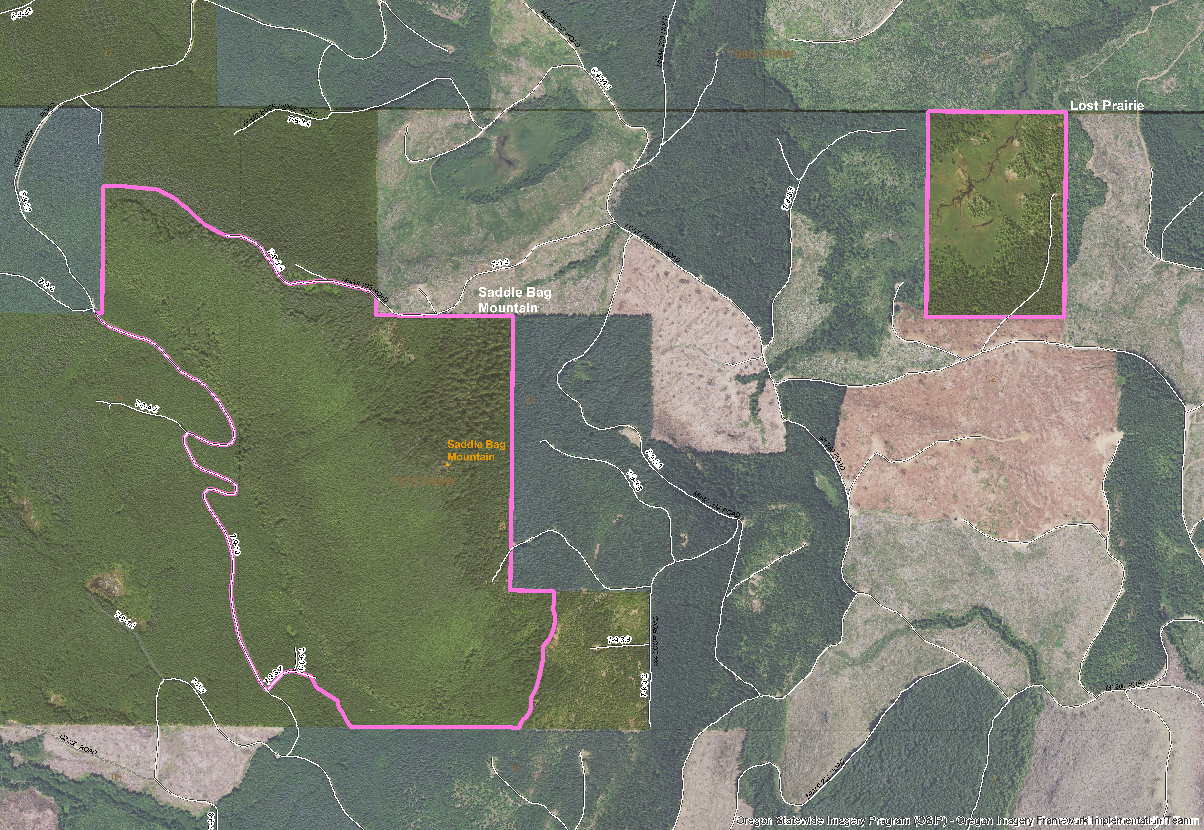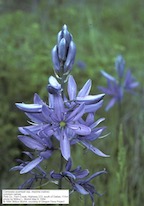NPSO 2024 Annual Meeting
May 17 - 19 Spirit Mountain Hotel, Grand Ronde, Oregon
Field Trips
Friday May 17, 2024 1 - 4 p.m. Field Trip # 6
Lost Prairie and Saddle Bag Mountain
 Photo: BLM Northwest Oregon District
Photo: BLM Northwest Oregon District
Lost Prairie in the Coast Range
Difficulty: Easy to moderate (1 or more miles) - footing in the bog is uneven and wet in places. Lost Prairie: no developed trails, foot access by wildlife trails with dense shrubs in places. Saddle Bag Mountain: no developed trails; thick undergrowth on the edge, then open.
Elevation: Mostly level; optional hike to Saddle Bag Mountain summit 300 feet
Group Size Limit: LIMIT REACHED, TRIP FULL
 Photo: BLM Northwest Oregon District
Photo: BLM Northwest Oregon District
Insectivorous round-leaved sundew (Drosera rotundifolia)
Trip Description: Lost Prairie was designated as an Area of Critical Environmental Concern in 1984 to protect 60 acres of mid- to high-elevation sedge fen, sphagnum bog, and beaver marshes in the Oregon Coast Range. The fen is seasonally flooded and supports a diverse array of vascular plants and bryophytes that are uncommon in coastal coniferous forests of northwestern Oregon. Three sparsely vegetated basalt outcroppings surround the fen, and the center supports a "habitat island" with 150-year-old conifers. Rare plants include elegant fawn-lily (Erythronium elegans), bog anemone (Anemone oregana var. felix), Indian rice (Fritillaria camchatcensis), two rare lichens (Hypogymnia duplicata and Platismatia lacunosa), and a rare moss (Tetraplodon miniodes).
Low hummocks of dwarf bilberry (Vaccinium caespitosum) are interspersed around seasonally flooded openings with slough sedge (Carex obnupta), water sedge (C. aquatilis var. dives), western inflated sedge (C. exsiccata), Northwest Territory sedge (C. utriculata), and other graminoids. Sphagnum mendocinum and Aulacomnium palustre are the dominant mosses among the Vaccinium hummocks. Scouler's willow (Salix scouleriana) and Douglas spiraea (Spiraea douglasii) occasionally dominate as tall- or medium-sized shrubs. Stunted growth forms of Spiraea douglasii, Carex obnupta, and Camassia quamash ssp. quamash (common camas) suggest that the soil has low nutrient status. Great burnet (Sanguisorba officinalis) is a common herb along with grasses, such as tufted hairgrass (Deschampsia cespitosa), northern reedgrass (Calamagrostis stricta ssp. inexpansa), and spike bentgrass (Agrostis exarata).
Lost Prairie features the only known location of the mariposa copper butterfly (Lycaena mariposa candia) in the Coast Range. According to the Xerces Society, it represents a distinct subspecies and is related to a population found in the Siskiyou Mountains. The butterfly lays its eggs on Vaccinium caespitosum and prefers nectaring on Sanguisorba officinalis.
Saddle Bag Mountain Research Natural Area occupies 300 acres on the summit (elevation 3,290 feet) and western slopes of the mountain and was established to protect one of the last remaining stands of Pacific silver fir (Abies amabilis) in the Oregon Coast Range. Here, Pacific silver fir and noble fir (Abies procera) approach the southern limits of their natural ranges and occur as isolated remnants within a forest of western hemlock (Tsuga heterophylla) and Douglas fir (Pseudotsuga menziesii). Both Abies species may represent genetically unique populations owing to their long period of isolation. Many of the trees at the site are between 250 and 400 years old.
Where the slope is over 80 percent, little vegetation is found under the dense canopy of western hemlock except in the few openings that occur, mostly in areas with high water tables. In the areas of relatively open canopy, the understory consists of a sparse shrub layer with early blueberry (Vaccinium ovalifolium), swamp currant (Ribes lacustre), and salmonberry (Rubus spectabilis). Herbaceous species and mosses dominate the ground vegetation. Conspicuous herbs include Oregon wood sorrel (Oxalis oregana), cutleaf goldthread (Coptis laciniata), mountain sweet cicely (Osmorhiza berteroi), and trefoil foamflower (Tiarella trifoliata var. trifoliata).
Recently, surveys for both truffles and rare lichen/bryophytes have been completed. Final reports are not available at this time, but Bryoria bicolor, a rare fruticose lichen, has been located within the RNA.
Both hikes are in areas not open to the public.
Appropriate Clothing and Footwear: Sun hat (hard hat if available), long pants, and sturdy, waterproof boots, hiking poles.
Meeting Place and Time: Trip # 6 leaves at 1 p.m. from parking lot west of Hotel. Plan to arrive 30 minutes before departure time to meet your group and arrange carpools.
Alternate Meeting:
Participants may also meet the trip at 1:20 p.m. at at Van Duzer Corridor State Park Rest Area on south side of Highway 18. Rest Area website. If you choose this option, be sure to notify your trip leader in advance.
Driving Miles and Time from Spirit Mountain Hotel: 20 miles, 25 minutes to the Van Duzer Corridor Rest Area; gravel access road to Lost Prairie is about 2 miles east of the rest area; site is approximately 7.7 miles, 30 minutes on the gravel road; 2 miles, 5 minutes from the Lost Prairie ACEC parking area to Saddle Bag Mountain RNA.
Driving Directions: Trip leader will provide detailed driving instructions.
Leader: Heidi Christensen
Botanist/Invasive Plant Coordinator, Marys Peak Field Office, Northwest Oregon District BLM
Plant Lists and Other Information: Clink on the links below for more information about this trip.
 Photo: BLM Northwest Oregon District
Photo: BLM Northwest Oregon District
Wildflowers in the meadow at Lost Prairie

Map of Saddle Bag Mountain and Lost Prairie
 Photo: BLM Northwest Oregon District
Photo: BLM Northwest Oregon District
View of Lost Prairie marshland and part of Saddle Bag Mountain
 Photo: BLM Northwest Oregon District
Photo: BLM Northwest Oregon District
A solitary hiker on Saddle Bag Mountain


